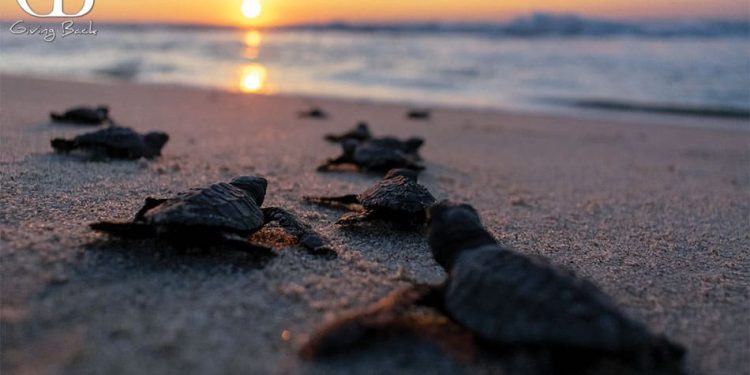WILDCOAST Sea Turtle Conservation

WANDERING WITH WILDCOAST
Sea Turtle Conservation in Oaxaca
By Serge Dedina, Ph.D., co-founder and Executive Director of WILDCOAST
Walking along a sandy path on a moonless night in Oaxaca, Mexico, the Milky Way reveals itself in all its humbling glory. In the distance, dark mounds come into focus, along Playa Escobilla, a nine-mile expanse that trims the warm waters of the Pacific Ocean.
Moving closer we discover an olive ridley sea turtle digging in the sand, preparing a nest for her eggs. Utterly exhausted, she has miraculously carried her 100-pound body across the shoreline, having traveled thousands of miles to return to the golden sands of her own birthright where she will lay 80 to 100 eggs.
A group led by WILDCOAST has come to witness an arribada, a mass nesting of olive ridley sea turtles. Founded in 2000, WILDCOAST is an international team that conserves coastal and marine ecosystems and addresses climate change with natural solutions. As the sun rises, a soft orange morning light reveals hundreds of the marine reptiles in various stages of nesting on this waterfront sanctuary.
A nearby female, protected by her olive green, heart-shaped shell, sweeps away the sand—her movements seemingly like the turtle version of a snow angel. After digging a hole and dropping her ping-pong sized eggs, she covers them and then returns to the sea, as reptiles such as these do not stay with their young.
After incubating for 45 days, these hatchlings will break free from their shells and, if lucky enough to make it, they, too, will head back into the sea.
Each year from July to January, the olive ridley turtles make their way to deposit millions of eggs along Oaxacan beaches such as Escobilla and Morro Ayuta.
This was not always the case. In the 1980s, olive ridleys were severely threatened due to the then legal trade in sea turtle meat and eggs in Mexico. Thankfully the Mexican government banned the trade in sea turtles in 1990.
To curb what developed into a very pervasive black market trade in sea turtle products in the 2000s, WILDCOAST launched a wildly successful “Don’t eat sea turtle” campaign to reduce the demand for eggs and meat.
Though still a vulnerable species, the olive ridley sea turtle is a hopeful example of conservation in action. More than 45 million sea turtles have been born on beaches protected by local communities, the Mexican government and WILDCOAST in Oaxaca since 2018.
To assure long term protection for olive ridleys, WILDCOAST is now working with the Mexican Turtle Center, Mexico’s National Commission of Natural Protected Areas (CONANP), and most importantly local communities to directly protect this critical sea turtle habitat. WILDCOAST has helped protect 71 miles of sea turtle beaches in Oaxaca.
Later that day, our group gets to release tiny olive ridley turtle hatchlings who are eager to scurry into the sea. WILDCOAST biologist Luis Rojas reminds us not to directly touch them, as the oils from human skin can interfere with their imprinting process.
We gently tip the coconut shells holding the fresh-from-the-egg baby turtles so they can begin their inaugural journey to the ocean, knowing some of them will one day return to lay their own eggs on this very beach where we stand. Needless to say, it is an exhilarating experience.
Sea turtle conservation is just one example of the many WILDCOAST projects around the world. WILDCOAST’s international team is helping to safeguard 38 million acres of globally significant coastlines and ocean habitats, coral reefs, sea turtle nesting beaches, gray whale breeding lagoons, mangrove forests, wetlands, islands and more.
For anyone interested in witnessing the spectacular synchronized mass nesting of olive ridley sea turtles, WILDCOAST offers annual trips to Oaxaca for their VIP donors. For more information, please contact Ann Wycoff at (619) 423-8665.





